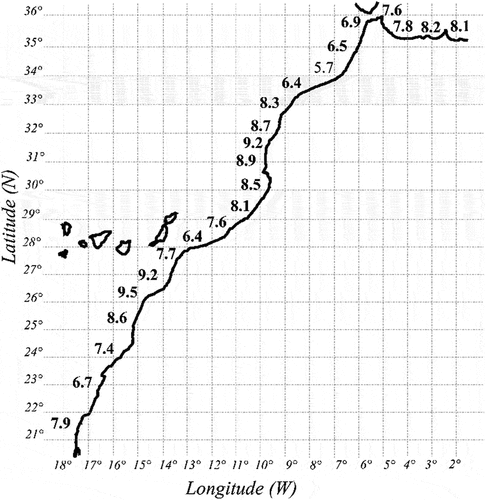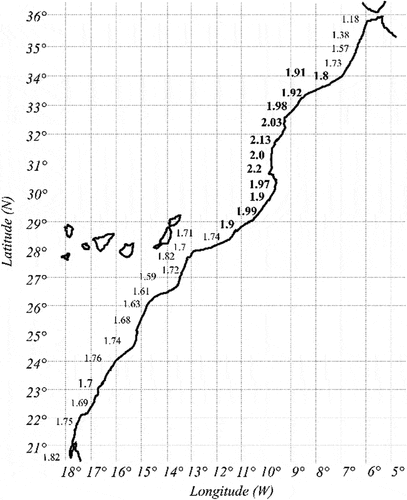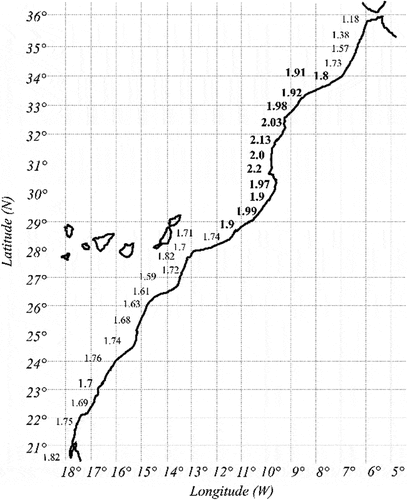 ?Mathematical formulae have been encoded as MathML and are displayed in this HTML version using MathJax in order to improve their display. Uncheck the box to turn MathJax off. This feature requires Javascript. Click on a formula to zoom.
?Mathematical formulae have been encoded as MathML and are displayed in this HTML version using MathJax in order to improve their display. Uncheck the box to turn MathJax off. This feature requires Javascript. Click on a formula to zoom.Abstract
Modern Morocco’s heavy dependence on foreign energy imports, combined with a rapidly growing population and an increasing demand for a better quality of life, makes the country’s future uncertain. Possessing rich and diversified renewable energy resources within its territory encouraged the Moroccan government to make ambitious plans to integrate renewable energy resources into its national grid on a big scale, 42% of its energy generating capacity from renewables by 2020, and 52% by 2030. This paper provides a first assessment of the offshore energy potential available near the coastline of Morocco. After a brief description of operations of offshore wind, tidal and wave power, a first order assessment of their potential is presented and discussed. This study shows that important offshore wind resources are available throughout the Mediterranean and the Atlantic coast of Morocco. This resource peaks between the regions of Al Jadida and Agadir, reaching a speed of 9_m/s. The bulk of the offshore resources are located at the Atlantic coastline of the country. Tidal stream resources are concentrated at the region of Tangier, where tidal speed is up to 1.9_m/s potentially producing 1.58_kW/m2. Oualidia lagoon was studied and found to be capable of producing more than 0.5_MW of electricity if a tidal barrage exploits 10% of its surface. Finally, ocean wave energy is available all over the Atlantic coastline and peaks between the regions of Essaouira and Agadir where the wave heights are between 1.9 and 2.13_m.
PUBLIC INTEREST STATEMENT
Morocco possesses very rich and diversified renewable energy resources such as wind, solar and hydroelectric power. The Moroccan authorities established an ambitious plan, referred to as the national Energy Strategy (NAS), aiming to integrate onshore renewable energy resources to its national grid, 42% of its energy generating capacity from renewables by 2020, and 52% by 2030. However, this plan excludes offshore renewables such as offshore wind, tidal and ocean wave power. This paper presents a comprehensive review and assessment of the available offshore energy resources along the 3,500 km Morocco’s coastline. It was found that important offshore wind resources are available near the region of Al Jadida. In addition, significant tidal streams are positioned near the region of Tangiers, in the north of the country. Finally, ocean wave energy peaks between the region of Essaouira and Agadir.
1. Introduction
Renewable energy is viewed to be clean and abundant on its primary format. Once in operation, it produces electricity without emitting greenhouse and toxic gases such as CO2 and NOx. In addition, it has positive effects from an economic standpoint, since it reduces the energy bill after an initial investment, creates new jobs and limits the dependence on energy imports. Many countries have accumulated significant experiences exploiting solar, wind and hydroelectric technologies. Their major challenges lie in their intermittent nature and how to integrate them into the electric grid, as many solutions were proposed to circumvent these challenges (Alaoui, Citation2017; Alaoui, Zineddine, & Nourddin, Citation2017; Hoseinzadeh & Azadi, Citation2017; Yousef Nezhad & Hoseinzadeh, Citation2017; Youssef, Fatima, & Chakib, Citation2018). Moreover, these technologies are becoming relatively easy to install and operate (Hardwick, Smith, Fitch-Roy, Connor, & Sundaram, Citation2018).
In spite of the benefits of renewable energy, the existing global renewable production is just a minor fraction of what is potentially available. Figure shows that the global renewable energy intake as of 2015 was 13.7% including hydro, biofuels and waste, geothermal, solar, wind and the various forms of ocean energy (International Energy Agency, Citation2017). Fossil-based fuels are expected to continue to supply most of the energy needs worldwide for the next decades. However, several reports shows a steady increase in the investment in renewable energy (Ellabban, Abu-Rub, & Blaabjerg, Citation2014; Kannan & Vakeesan, Citation2016).
Improving energy efficiency in residential, commercial and industrial sites constitute a second important axis for any country’s improvement of its energy bill (Hoseinzadeh, Hadi Zakeri, Shirkhani, & Chamkha, Citation2019). For instance, Morocco’s NES established targets for decreasing energy consumption by 12% by 2020 and 15% by 2030 through energy efficiency improvements in transport, industrial and residential sectors.
Figure 1. Total installed capacity of renewable energy as of 2015. Source (Hansen, Narbel, & Aksnes, Citation2017; Lynn, Citation2013; Renewable Energy Policy Network for the 21st Century (REN21), Citation2016)
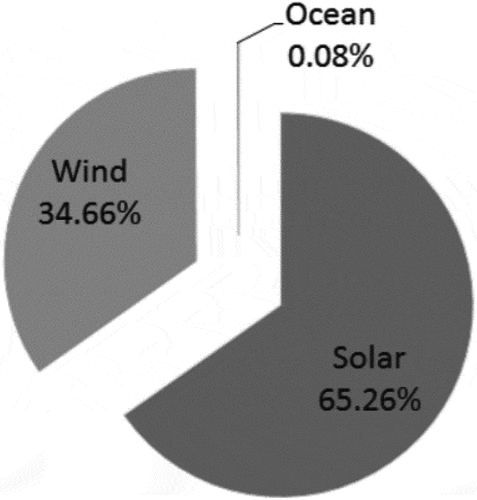
Offshore renewable sources are exploited to a lesser extent. For instance, ocean wave, tidal and offshore wind resources embody a very small portion of the global energy capacity, in spite of the large amount of potential energy available offshore, and of the successful experience of the few existing plants, especially in Canada, France, the UK, among others (Lynn, Citation2013). By the end of 2015, the cumulative tidal renewables installed worldwide was limited to 530 MW, excluding pilot and demonstration projects (Renewable Energy Policy Network for the 21st Century (REN21), Citation2016).
Despite its strategic geographical location, Morocco is still suffering from a negative energy balance, since it imports more than 95.5% of its energy needs. The overall Moroccan energy bill is expected to triple by 2030 (Library of the European Parliament (LEP), Citation2013; Ministry of Energy, Mines, Water and Environment (MEMEE), Citation2011; Norton Rose Fulbright, Citation2012). In order to improve the energy balance, the Moroccan government has established an ambitious energy plan, referred to as the National Energy Strategy (NES) (Alhamwi, Kleinhans, Weitemeyer, & Vogt, Citation2015). Its main objective is to increase the share of renewable energy resources intake into the national grid, reaching 42% of the electricity generated from renewable energy resources by 2020, including a 2,000_MW for each of solar, wind, and hydroelectric power. This share of renewable energy intake is to be increased to 52% by 2030 (Alhamwi et al., Citation2015; International Renewable Energy Agency (IRENA), Citation2014). In addition, the total energy consumed is to be decreased by 12% by 2020 and by 15% by 2030 by applying energy efficiency technologies (EET) in key sectors in the country, such as transport, industrial and residential sectors. The NES has defined solar, wind and hydropower as “high priority” resources due to their abundance in the country, their falling prices and their maturity. However, NES has excluded offshore energy resources because they are viewed as expensive and having low maturity levels. This resource is gaining competitive advantages and benefitting from falling prices. Many countries worldwide are adopting various offshore technologies with some degree of success (Ellabban et al., Citation2014; Hardwick et al., Citation2018; International Energy Agency, Citation2017; Kannan & Vakeesan, Citation2016). Hence, Moroccan authorities should make the needed feasibility studies about the adoption of offshore energy resources and their integration into the national grid.
There is a lack of published papers on Moroccan offshore energy resources assessment. This manuscript presents a first order assessment of offshore renewable energy available within the 35,000 km of the coastline of Morocco, namely offshore wind, wave and tidal power. This study excludes other ocean resources such as thermal and salinity gradients energies, as they are still on their early stage of maturity.
The rest of this paper is organized as follows; section 2 gives a brief geographical overview of Morocco and its climate. Followed by an assessment of offshore wind power, tidal power and ocean wave energy in Morocco. This manuscript ends with a conclusion.
2. Overview of Morocco’s geography
2.1. Morocco’s geography
Morocco is located in the northwestern part of Africa and at 13_Km south of Europe. The kingdom of Morocco is viewed as a bridge between Europe and Africa, and between the east and the west thanks to its strategic geographical position. It has a coastline of 3,500_Km including the Mediterranean sea by the north and the Atlantic ocean by the west. Several Mountain ranges, such as Atlas mountains rising as high as 4000_m above sea level, and several rivers dominate the country’s landscape. The Kingdom lies between two climatic zones, north moderate and tropical south, which allows distinguishing four types of climate: humid, sub-humid, semi-arid and arid. In addition, the climatic observations over the last decades confirm progression of the semi-arid climate towards the North of the country. Figure shows Morocco’s map.
Several studies have indicated that oil reserves are present in the Moroccan territory; however, they remain unexploited as the time of writing (Chham et al., Citation2018). The extraction of other fossil fuel resources is in development, but it is advancing at a slow pace. Due to this lack of fossil fuel resources, Morocco is required to import 95.5% of its energy (Chentouf & Allouch, Citation2018). This includes crude oil, refined oil, and coal, having Saudi Arabia as a major provider, who supplies 48% of Morocco’s energy requirements (Alhamwi et al., Citation2015; Amara, Citation2011).
2.2. The Mediterranean coast of Morocco
The Mediterranean Sea is a closed sea that has deep waters. Ocean energy resources, such as tidal and wave energies, in this area are very weak for viable exploitation, except for three sites: the French Blue Coast, the Sicily Straight and the Greek islands (Pérez-Collazo, Greaves, & Iglesias., Citation2015). This claim is supported by data such as in Figure . The authors of (Soukissian et al., Citation2017) did a review of offshore energy resources that are available in the Mediterranean Sea. They concluded that tidal and wave energy is very limited near the Moroccan territory. Therefore, there is no interest on developing tidal energy infrastructure. Typically, tidal turbines need a stream speed of at least 1.5–2 m/s in order to operate effectively. Hence, this paper focuses more on the Atlantic coast where the bulk of the tidal and wave resources are available.
Figure 3. Mean annual significant wave height and direction for the Mediterranean Sea and near the coast of Morocco. (Soukissian et al., Citation2017)
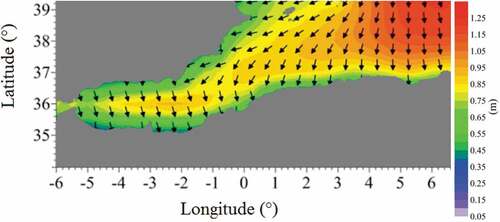
3. “Low priority” renewable energy resources: an assessment
3.1. Low priority—high priority renewable resources
Marine renewable energy (MRE—offshore wind, wave and tidal), also known as ocean energy or offshore renewable energy, holds an immense potential for enhancing the diversity of energy input, reducing greenhouse gas emissions and stimulating the economies of the host countries. The author of (Cruz, Citation2007) estimated that 0.2% of Ocean’s untapped energy could provide enough power to the entire world.
According to (Airoldi, Serri, & Stella, Citation2012), the EU renewable energy targets for 2020 and international policies have defined offshore energy resources as a high priority. Moreover, the 2050 international and European targets for the development of offshore wind and ocean energies are listed in Table (Airoldi et al., Citation2012).
Table 1. 2050 offshore wind and ocean energy targets. Source (Airoldi et al., Citation2012; Bahaj, Citation2011; Citation2010)
Ocean energy is constant, not exhaustible and more predictable than the other renewable resources such as solar and onshore wind renewables. The NES has defined solar, onshore wind and hydroelectric as “high priority” energy resources because of the maturity of their technologies, their falling overall costs and the vast availability of these resources within the country. However, having a coastline of 35,000_Km and sharing similar conditions to Spain, Portugal, France and the UK, who are the leading countries of offshore energy resources (Muñoz Arjona, Huertas Olivares, Holmes, Magagna, & Greaves, Citation2012; Pelc & Fujita, Citation2002), and to the equally resourceful islands of Archipelago of Azores, Madeira Archipelago and Canary Islands (Rusu & Onea, Citation2016), Morocco possesses important unexploited offshore resources. Equally significant is the fact that most of the energy is demanded in coastal areas where the major cities are located (Nachtane, Tarfaoui, Hilmi, Saifaoui, & El Moumen, Citation2018).
There are many benefits that the various types of ocean energies may offer to Morocco, as energy is produced just off the coast, making it easy to import to nearby populations. Close proximity to a power generation area shortens power line distances, reducing electricity distribution costs, and increasing the reliability of service (Magagna et al., Citation2014). Offshore energy embraces several forms of energy extraction from oceans, and the most common and effective offshore technologies developed so far are based on offshore wind, ocean waves and tides. The NES has decided to categorize these resources as “low priority” because of their higher initial and O&M costs, and perceived as immature. However, the overall costs of offshore wind are diminishing down to USD 0.14/kWh according to (World Energy Council, Citation2013). The authors of (Astariz & Iglesias, Citation2015; Bhattacharya, Citation2019) predicted a decrease of offshore renewable technologies cost thanks to their adoption by several countries. These renewable resources might contribute to the success of the NES. However, there is a lack of a qualitative and quantitative analysis of the potential of offshore renewable resources currently available in the country. This paper presents a first order estimation of the available potential existing along the coastlines of Morocco. A “physical resource potential” is first presented. It considers the observed physical resource natural characteristics such as wind speeds, tidal current velocities and wave heights. In order to estimate the technical potential of the offshore resources, an adequate technology should be selected in order to quantify the extractable power and energy.
3.2. Offshore wind power
Over the last 20 years, onshore wind technology has seen a dramatic decrease of its overall costs, and became competitive with fossil fuel and nuclear-based electricity generation in some areas like the U.S. (Astariz & Iglesias, Citation2015). Some even speculate that this source will become the cheapest form of the energy in the industrialized world (Bhattacharya, Citation2019). The initial interest of onshore wind energy exploitation was triggered near windy cites. However, these are usually situated in remote areas, which incurs additional costs for transmission (Monthy, Citation2003). On the other hand, the wind speed in the sea is higher than on land: from 30 to 40% higher in the open ocean and about 15 to 20% higher near the shore. Subsequently, an offshore wind farm, therefore, can generate up to 50 to 70% more power and reduce its electricity costs; even with a higher cost of installation in deep water (Giebel, Mortensen, & Czisch, Citation2003). In addition, offshore wind is characterized by the increased consistency and predictability of wind patterns. Offshore wind power reliability has been put under test when, on 19 October 2014, Didcot power station was unexpectedly caught on fire and was temporarily shut down, then 24% of the electricity supply of the UK was provided by offshore wind only. In addition, on 21 October 2014, UK wind farms generated 14.2% of the electricity, which is more than the electricity generated by its nuclear power station (13.2%) for a 24-hour period when few of the nuclear power stations were offline due to maintenance and technical issues (Monthy, Citation2003).
3.2.1. Power of offshore wind turbines
The mechanical power output at the rotor shaft of a wind turbine can be expressed by Equationequation 1(1)
(1) , where Cp is the coefficient of performance (usually between 0.2 and 0.4), As is the area swept are by the blades, ρ is the density of air (1,225 kg/m3) and V is the average wind speed (m/s) (Lu, Hong, & Xu, Citation2019).
In order to assess the obtainable power/energy numerically, the wind turbine GE 3.6s was selected for this study. Its rated power is 3.6_MW, having a rotor diameter of 104_m with three blades. In addition, in order to estimate the total power that could be produced by an offshore resource, the choice of inter-turbine spacing is important, since it represents a trade-off between more power per unit area (closer spacing) versus more power per machine (wider spacing). The recommended trade-off is to keep inter-turbine wake losses below 10% by keeping the downstream spacing no less than 10 rotor diameters and crosswind spacing 5 rotor diameters according to (Manwell, McGowan, & Rogers, Citation2002). For the selected turbine having 104_m blade, this array spacing corresponds to 0.54 km2 per turbine.
An in-depth knowledge of offshore wind resources allows an assessment on the wind farm productivity and financial viability of the project. As a rule of thumb, a project is not financially worthwhile if the average wind speed at the hub height is below 6_m/s, and it is considered a safe venture if the average wind speed is more than 8.5_m/s (Bhattacharya, Citation2019).
3.2.2. Overview of offshore wind substructures
Offshore wind substructures knew a relatively faster development during the last twenty years, thanks to the combined efforts of onshore wind and offshore drilling technologies. Several specific offshore substructures were proposed according to water depths. Figure shows the substructures according to (i) shallow water, (ii) transitional water, and (iii) deep water, also known as floating (Pérez-Collazo et al., Citation2015). Their main characteristics are shown in Table . Figures , and illustrate shallow water, transition water and deep water substructures respectively.
Figure 4. Substructure technologies according to water depth (Pérez-Collazo et al., Citation2015)
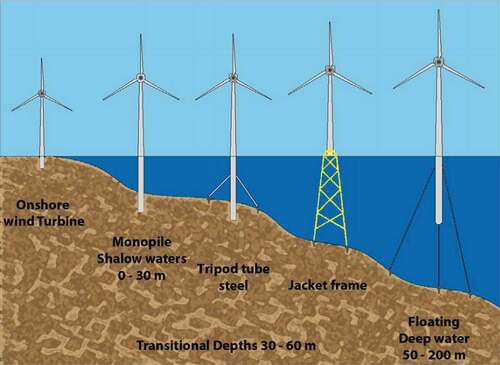
Figure 5. Shallow water substructures: (a) gravity, (b) monopile and (c) suction bucket (Pérez-Collazo et al., Citation2015)
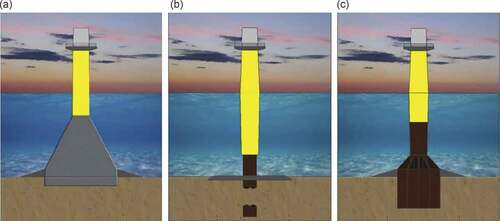
Figure 6. Transition water substructures: (a) jacket frame, (b) tri-pile and (c) tripod (Pérez-Collazo et al., Citation2015)
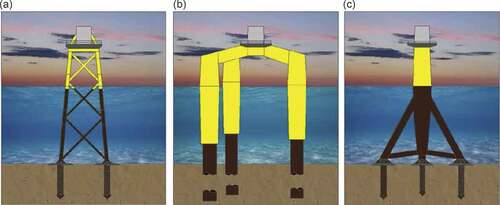
Figure 7. Deep water or floating substructures: (a) spar floater, (b) tensioned-leg and (c) semi-submersible (Pérez-Collazo et al., Citation2015)

Table 2. Substructures for offshore wind turbines
3.2.3. Morocco’ offshore wind power potential
The Moroccan authorities have not considered offshore wind projects at the time of writing of this article. Reasons include the apparent immaturity of this technology, in addition to the substantial onshore wind energy that could be developed instead. The costs associated with offshore wind are high compared with other renewables. However, their growing worldwide deployment along with their constant technological improvements are likely to make this renewable more cost-effective in the near future (Monthy, Citation2003).
The southern part of the Atlantic coast of Morocco possesses very good wind resource according to (Giebel et al., Citation2003). The wind comes from the Atlantic Ocean onto the shore in the area of the trade winds (Citation2019). Table recapitulates wind data collected in some major coastal cities of the Atlantic coast of Morocco from (Giebel et al., Citation2003). All measurements were done at 40_m height.
Table 3. Offshore wind speed in the southern Atlantic coast of Morocco
The authors of (Mederos, Padrón, & Lorenzo, Citation2011) analyzed the offshore wind potential in the neighboring Islands to Morocco by using data processed from several weather stations and satellite data. Their study concluded the availability of a great offshore wind resource in the southern part of the Atlantic coast of Morocco. The island of Fuerteventura, being about 90_km off coast of Morocco, had power potential shown in Table .
Table 4. Offshore wind speed at the island of Fuerteventura
The technical potential of offshore wind for the African continent was assessed in (Elsner, Citation2019), employing long-term data of satellite-based wind speed measurements. The authors used two scenarios reflecting the technological maturity of the wind availability. By using similar means of (Mederos et al., Citation2011), a shallow-water scenario assumes that the current level of technology will not improve; then, a deep-water scenario assumes the operational availability of floating platforms that would allow access to wind resources at much deeper water depths. In order to quantify the technical potential of these resources in terms of the extractable power and energy, the authors used a 5_MW turbine with a spacing distance of 10 rotor diameters (Musial, Heimiller, Beiter, Scott, & Draxl, Citation2016). Calculating a 10-rotor diameter distance for the Vestas V164-8 MW turbine results in a packing density of 3_MW/km2 (Bosch, Staffell, & Hawkes, Citation2018). Table shows very favorable offshore wind resources, especially on the south Atlantic coast of Morocco, from El Jadida (lat: 33.33°, long: −8.41°) to Laguira (Lat: 21.10°, long: −17.18°) and in the northern part, from Tangiers (lat: 35.84°, long: −5.80°) to Larache (lat: 35.17°, long: −6.14°).
Table 5. Resource and technical offshore wind energy potential of Morocco (Including Western Sahara)
3.2.4. Discussion
The Moroccan offshore wind resources are summarized in Figure , and expressed in terms of offshore average wind speed in m/s. This map shows that Morocco possesses good wind resources throughout its coastal line, since the wind speeds exceed 8.5_m/s in most locations, except in Larache region, where the averaged wind speed was 5.7_m/s. Moreover, the wind resources between El Jadida and Agadir, covering the offshore area delimited by (lat 30°, long 10°) and (lat 33°, long 9°), possesses excellent wind resources exceeding 9_m/s, or an equivalent power of 2.8_MW/Km2.
3.3. Tidal power
Tidal energy, also known as marine current energy (MCE), is one of the oldest forms of renewable energy. It has been the focus of several research centers and universities that are located on the Atlantic ocean and neighboring to Morocco such as in Spain (Carballo, Iglesias, & Castro, Citation2009; Iglesias et al., Citation2009), Portugal (Dias & Fernandes, Citation2006), France(Guillou, Neill, & Robins, Citation2018; Le Roy & Simon, Citation2003), the UK (Blunden & Bahaj, Citation2006; Serhadliogluet, Adcock, Houlsby, Draper, & Borthwick, Citation2013), and many others (Abbaspour and Rahimi, Citation2011; Cornett, Durand, & Serrer, Citation2010; Mejia-Olivares et al., Citation2018). Marine currents are formed from tidal movements and ocean circulations. Tides are the result of the interaction between the gravitational fields of the Earth, Moon, and Sun. This makes this type of renewable energy little influenced from ambient conditions such as weather, but rather by the cyclical constellations, the gravity of the moon, sun and earth, providing a foreseeable bi-week, biannual and annual cycles. Tidal movements cause an elevation of water level, and thus increasing the potential energy available in the water, in addition to underwater tidal streams that can be viewed as a kinetic energy. Conventionally, a barrage converts tidal energy into electrical energy by storing and releasing water to pass through the turbine generators (Andre, Citation1978). Otherwise, tide-induced water currents are exploited to drive underwater tidal stream turbines that are similar to wind turbines (Webb, Citation1982). In addition, the MCE resource has many advantages over other renewable energy resources. It is characterized by its predictability over long time thanks to the cyclic ability of high and low tides (Ferro, Citation2006; Pelc & Fujita, Citation2002) and by having the density of seawater 823 times greater than the density of air (Kiho, Citation2011), though the water flow speeds are much smaller (Hazim, EL Ouatouati, & Janan, Citation2016). There are two forms of practical tidal energy harvesting methodologies, tidal barrage and tidal stream technologies. The following sections give a brief overview.
3.4. Tidal barrage
3.4.1. Principles
A tidal barrage is also referred to as tidal range. It is constructed by taking advantage of the variation between low and high tides (International Renewable Energy Agency, Citation2014) as illustrated in Figure . It shows a semi-permeable barrage across estuaries submitted to a high tidal range. The principles that are used in this case are based on flood generation, ebb generation, or flood and ebb generation.
Figure 9. Operational process of a tidal barrage (International Renewable Energy Agency, Citation2014)
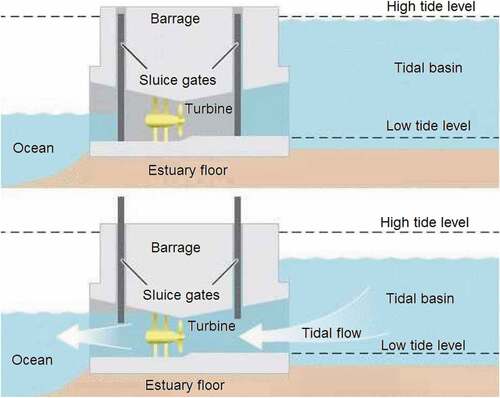
3.4.2. Theoretical energy estimation from tidal barrage
When the water’s elevation is higher than the normal elevation, a tidal barrage is used to store the water’s potential energy during flooding tides. This energy will be exploited during the ebbing phase on a barrage. The total available energy depends on the area of the water surface held by the barrage and the corresponding magnitude of the tidal range. EquationEquation (2)(2)
(2) expresses the energy contained in the water volume impounded in a basin (Mendi, Reddy, Seelam, & Rao, Citation2019; Murali & Sundar, Citation2017).
where Ep is the potential energy over a tide cycle, ρ is the density of sea water (typically 1.025_ton/m3), g is the acceleration due to the earth’s gravity (9.807_m/s2), A is the horizontal area of the enclosed basin (km2), and h is the mean tidal range in the basin (m). EquationEquation (2)(2)
(2) indicate that the mean tidal range, followed by the value of the held area, are the most important factors that determine the viability of a tidal barrage in terms of the annual energy production. The average electric power generated by a lagoon or a barrage depends on the generation time T and of the efficiency of the energy conversion process ηc as shows in EquationEquation 3
(3)
(3) (Mendi et al., Citation2019).
The efficiency ηc depends on energy losses that occur through the system and the operating point of the turbines (Betz, Citation1966; Gorban, Gorlov, & Silantyev, Citation2001; Walker, Flack, Lust, Schultz, & Luznik, Citation2014). In addition, the capacity factor CF quantifies the efficiency of energy sources by using EquationEquation 4(4)
(4) . Several studies, such as (Mendi et al., Citation2019; Petley & Aggidis, Citation2016), have estimated a realistic value of 0.2 for CF. Table shows some constructed tidal barrages worldwide along with some of their technical specifications (International Renewable Energy Agency, Citation2014).
Table 6. Tidal barrage example specifications
3.4.3. Case study: Oualidia lagoon
Oualidia lagoon (lat: 32°–long: 09°) is located on the Atlantic Ocean between El Jadida and Safi as shown in Figure (Hilmi, Koutitonsky, Orbi, Lakhdar, & Chagdali, Citation2005). This lagoon is 7_km long, averages 0.5_km wide and exchanges water with the ocean through a major inlet of about 150_m width and an average of 2_m deep.
Figure 10. Oualidia lagoon and its bathymetry (adapted from (Hilmi et al., Citation2005))
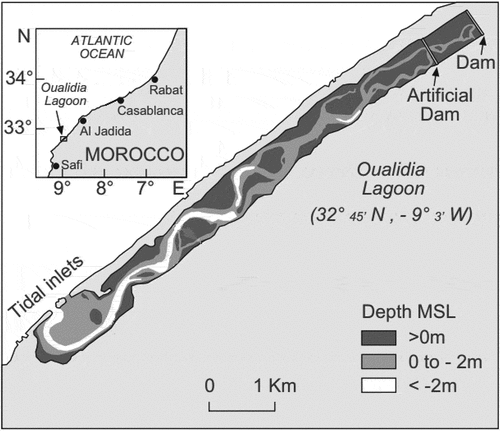
The region of our study is located at the end of the lagoon where an artificial dam was installed as shown in Figure . In order to estimate the potential annual energy, the tidal data for lagoon was retrieved from (Hilmi et al., Citation2005). The area of the installed barrage is 0.36_km2, and has an average annual tidal range of 1.99_m. The potential energy stored inside the lagoon can be calculated by applying (2), where the average tidal range as differential height is expressed in (5).
Since the barrage is filled and emptied twice a day, the annual potential energy can be expressed in (6).
Finally, by assuming that generation takes place 14 h a day, the average power generation can be estimated by using (7).
The total surface used for this barrage is about 10% of the total surface of Oualidia lagoon. This was done in order not to disturb the naval traffic and other activities.
3.5. Tidal stream turbine
3.5.1. Principles
A tidal stream turbine relies on harnessing tidal streams using underwater hydrokinetic turbine, similar to that used in onshore wind turbine to extract wind energy. Figure –14 show different solutions for tidal streams power generation that convert water kinetic energy into electric power (Wilberforce et al., Citation2019). Table shows major tidal stream turbines technology.
Figure 11. Horizontal axis turbine (left: Artist drawing, right: SeaGen S) (Sangiuliano, Citation2017)
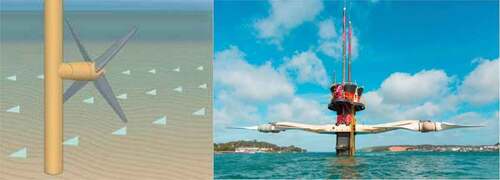
Figure 12. Vertical axis turbine (left: Artist drawing, right: Kobolt)(Brinck & Jeremejeff, Citation2013; Coiro, Nicolosi, Moroso, & Soprano, Citation2003)
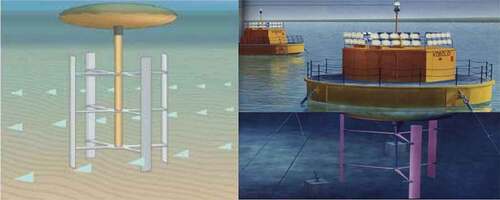
Figure 13. Oscillatory hydrofoil (left: Artist drawing, right: Stingray) (Brinck & Jeremejeff, Citation2013; Coiro et al., Citation2003)
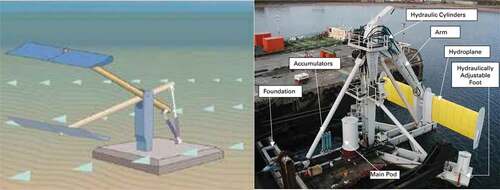
Figure 14. Venturi effect turbine (left: Artist drawing, right: Stingray) (Brinck & Jeremejeff, Citation2013; Coiro et al., Citation2003)
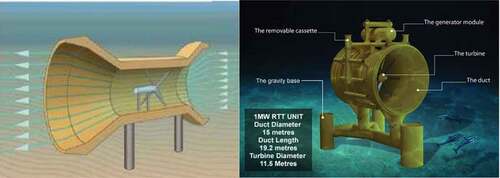
Table 7. Major tidal stream turbines technology
In addition, this technology has a relatively lower impact on the environment (Ferro, Citation2006), does not use farmland such as onshore wind and solar, and does not perturb local ecosystem such as hydropower systems. Once mounted on concrete structures, which have typically a lifespan of 100 years. MCE can last four times more the longevity of wind and solar forms (Hammond, Jones, & Spevack, Citation2014). The downside of this technology is the relatively high construction costs, which are about a double of those of onshore wind (Denny, Citation2009). Finally, a little is known about the dangers of electromagnetic emissions on marine life. Big barrages have a potential of disturbing ocean levels and can have similar negative effects as hydroelectric power. The following section outlines the theoretical estimation of tidal energy in Moroccan shores.
3.5.2. Theoretical estimation of energy from tidal currents
The tidal generators make use of the kinetic energy of water stream that spins the turbine and drives the generator to produce electricity. The power density generated by the tidal turbine is given by EquationEquation (8)(8)
(8) (Artal, Pizarro, & Sepúlveda, Citation2019; Elghali, Ben, Outbib, & Benbouzid, Citation2019).
where Pk is the power density per turbine swept area (W/m2), ρ is the density of sea water (1.025_ton/m3), Cp is the power coefficient of the turbine. For a single isolated turbine, the Betz analysis of the theoretical limit of Cp ≤ 0.59, however, in practice, commercial turbines have Cp = 0.4 (Artal et al., Citation2019; Elghali et al., Citation2019). Finally, V is the velocity of the tidal current (m/s). EquationEquation (8)(8)
(8) shows that the tidal current velocity is the major factor determining the economic feasibility of tidal stream turbine in an area. The power increases rapidly with the speed of the current, and it is generally considered that tidal turbines become economically viable if the current exceeds 2_m/s. Moreover, the vertical variation of the speed varies according to EquationEquation (9)
(9)
(9) (Elghali et al., Citation2019; Pelc & Fujita, Citation2002).
where z is the distance above the bottom, p the depth, V0 the speed of the current at the surface. In fact, the maximum speed is usually located slightly below the free surface.
The Mediterranean Sea possesses interesting sites having tidal energy such as the Straits of Dardanelles, Gibraltar, and the Strait of Messina (Nachtane et al., Citation2018). Several research studies have indicated that the greatest potential for marine current energy is situated were high waves and strong wind are located (Khan, Bhuyan, Iqbal, & Quaicoe, Citation2009; Pelc & Fujita, Citation2002). The authors of (Pelc & Fujita, Citation2002) recommended the installation of tidal fences and turbines where tidal currents are greater than 1.5_m/s, while taking into account the constraints of topography. The authors of (Defne, Haas, & Fritz, Citation2011) demonstrated that the Atlantic coast has an important annual potential. It was reported in (Quesada, Lafuente, Garrido, Sammartino, & Delgado, Citation2014) that important offshore energy potential is available in the north of Morocco, from the Mediterranean side. The author of (Candela, Winant, & Ruiz, Citation1990) reported that the strait of Gibraltar possesses an important tidal energy potential.
A 3D numerical model SWAN to simulate tidal flows across the three Moroccan coast sites was used in (Hazim, El Ouatouati, Janan, & Ghennioui, Citation2019). These sites were selected in order to assess the energy potential of the Mediterranean Sea at the city of Tangier, near the strait of Gibraltar, the South Atlantic by the city of Tarfaya and North Atlantic by the city of El Jadida. Table shows the outcomes of the tidal energy assessment. Current velocities greater than 2.5_m/s were found in the North Atlantic, offering a theoretical power of 3.2_W/m2.
Table 8. Tidal energy assessment in Moroccan coastline
The authors of (Nachtane et al., Citation2018) evaluated the tidal marine current resource at the sites that are potentially suitable for the installation of Horizontal Axis Marine Current Turbines in Morocco, by using the Copernicus Marine Environment Monitoring Service (CMEMS) database. Figure summarizes their findings in the shape of tidal currents velocity rose diagrams corresponding to five major cities at the Atlantic ocean, Tanger, Agadir, El Hoceima, Dakhla and El Jadida. No additional investigations about the potentials of tidal energy in Morocco were found at the time of writing.
Figure 15. Marine current velocity rose diagrams. (a) Tanger, (b) Agadir, (c) El Hoceima, (d) Dakhla and (e) El Jadida. (Nachtane et al., Citation2018)
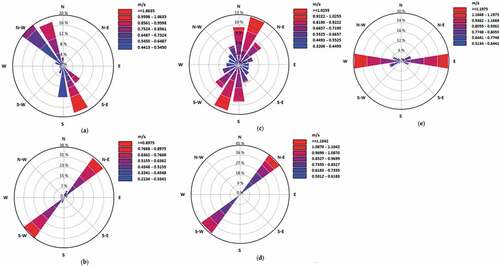
The most significant potential for tidal energy in Morocco is located around the Strait of Gibraltar near Tangier and Tetouan region, where the maximal and mean depth-average velocity is greater than 2_m/s and between 0.9_m/s to 1.8_m/s, respectively. The maximal and mean power density are 1.6_kW/m2 and between 200_W/m2 and 600_W/m2. Followed by El Jadida region.
3.6. Wave power
3.6.1. Principle
Wave energy is formed by wind combined with the atmosphere’s redistribution of solar energy. Waves are established over oceanic distances to energy densities averaging over 100_kW/m, as wave energy is typically measured in power per meter width of wave front (Barstow, Mollison, & Cruz, Citation2008). The same source assessed some major advantages of this offshore renewable energy resource; it has a high quality form, i.e. mechanical energy of oscillation, and that it travels long distances with slight loss, so that slight inputs over a large ocean can accumulate and be collected at or near the ocean’s edge. Moreover, wave power at a well suited site is available up to 90 percent of the time, while solar and wind availability tend to be available just about 20–30 percent of the time (Power buoys: electricity from waves, Citation2001). Further advantages comprise the point absorber effect, in which the devices can extract energy from a portion of a wavelength on either side; this possibility makes small devices with capacities of the order of 1_MW (Barstow et al., Citation2008). Other researchers, such as in (Falnes, Citation2002; Mork, Barstow, Kabuth, & Pontes, Citation2010), estimated that the global power resource to be in the order of 3.5_TW.
Energy can be absorbed form waves according to several methods and according to environmental data such as water depth and distance from coastline, in addition to their working principle (point absorbers or large absorbers) (Sheng, Citation2019). Figure –19 and Table describe some common structures used as wave converter.
Figure 16. Oscillating water column (Heath, Whittaker, & Boake, Citation2000; Citation2019)
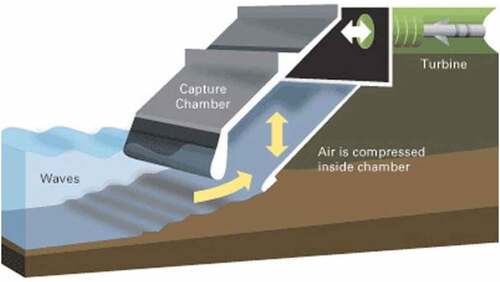
Figure 17. Oscillating bodies (Tarrant & Meskell, Citation2016)

Figure 18. Pelamis wave converter (He, Qu, & Li, Citation2013)
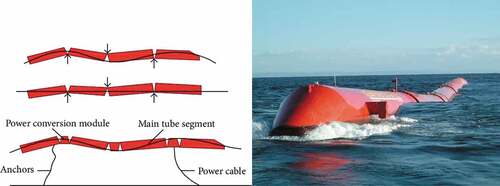
Figure 19. Overtopping illustration (left), Wave Dragon (right) (Parmeggiani, Kofoed, & Friis-Madsen, Citation2013)

Table 10. Annual energy output and capacity factors using Wave Dragon and Pelamis (Iglesias & Carballo, Citation2009)
3.6.2. Theoretical energy estimation of a wave conversion system
The wave power near the coastline of Morocco is calculated based on the buoy data introduced above by means of the expression of EquationEquation (10)(10)
(10) (Cornett, Citation2008; Mork et al., Citation2010; Wu, Liu, & Chen, Citation2015).
in which Pw is the wave power per unit of crest length (kW/m), ρ is the density of seawater (1025 kg/m3) and g is the gravitational acceleration, Hs is the significant wave height and Te is the energy period. According to (Barstow, Mørk, Lønseth, & Mathisen, Citation2009; Boronowski, Wild, Rowe, & van Kooten, Citation2010), and in order to keep the calculations simple, the peak period TP was used instead by applying the relation Te = 0.9Tp. The annual energy Pyearly production can be estimated by using EquationEquation (11)(11)
(11) .
where WAbs is the width of the absorber, ηww is the overall wave-to-wire efficiency (0.95 is a typical value) and Cp is the coefficient of performance. Cp = 0.2 is a typical value for wave energy according to the same sources.
3.6.3. Wave power in Morocco
Despite the enormous potential of the wave power, economically harvesting this energy remains a challenging problem, especially for Morocco. Hence, the contribution of wave energy in the renewable energy scheme remains absent at the time of writing of this article. Moreover, wave energy occupies a “low priority” in the NES. However, we believe that wave energy should be assessed since many researchers have indicated that it is concentrated between 30° and 70° north and south latitudes, where Morocco in located (Iglesias & Carballo, Citation2009; Sierra, Martin, Mösso, Mestres, & Jebbad, Citation2016). In addition, the researchers of (Henriques, Candido, Pontes, & Falcao, Citation2013; Iglesias & Carballo, Citation2009, Citation2011, Citation2010a, Citation2010b; Rusu & Onea, Citation2015) have estimated that the annual gross theoretical wave power is more significant on the western coasts of the continents (Portugal, Spain and Morocco), due to the prevalence of west-to-east winds.
The authors of (Iglesias & Carballo, Citation2009) assessed the wave energy potential that is available in the Atlantic coastline of Morocco. They used a 44-year series of data obtained from numerical modeling (i.e. hindcasting). The estimated resources possess an average wave power up to 30_kW/m and average annual wave energy up to 262_MWh/m. They analyzed 23 points are analyzed for investigating their wave energy potential. Figure shows Morocco’s map showing the locations of the 23 studied points (adopted from (Iglesias & Carballo, Citation2009)).
Figure 20. Locations of the 23 studied points for ocean wave energy (Iglesias & Carballo, Citation2009)
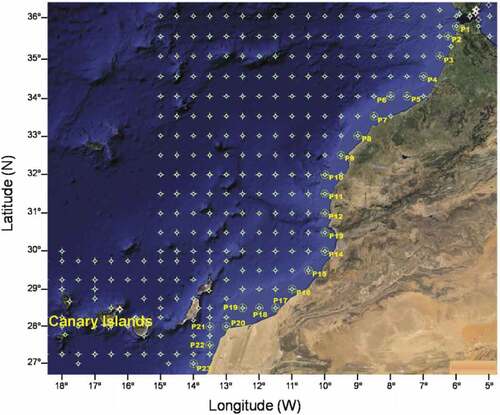
Figure shows the wave energy resources along the Atlantic coast of Morocco. The most significant resources exist between the region of Essaouira and Agadir (lat: 34°, lng: 7°) and (lat: 18.5°, lng: 11.5°) where the wave heights are between 1.9 and 2.13_m.
4. Conclusion
Currently, and in spite of its large potential for wind and solar renewable resources, the energy supplies in Morocco come mainly from fossil fuel resources. The National energy strategy (NES) defined the solar, wind and hydropower as “high priority” resources in order to establish an ambitious renewable energy program. However, having a coastline of 3500_km offers an important potential of offshore renewable energy resources.
This paper presented an overview of the offshore renewable energy resources that are available in Morocco. This country shares the Atlantic Ocean with leading countries in offshore technology research such as the UK, France, Portugal and Spain. Literature review and data analysis showed that Morocco possesses important offshore resources, especially along its Atlantic coast. For instance, important offshore wind resources are concentrated between the regions of El Jadida and Agadir, where the wind speed peaks at 9_m/s. Regarding tidal stream power, significant resources exist near Tangiers with speeds up to 1.9_m/s. This speed could produce 1.58_kW/m2 of electricity. Oualidia lagoon was also studied and utilized as a scenario for the installation of a tidal barrage. If only 10% of the total surface of the lagoon is exploited by a tidal barrage, 0.5_MW of electricity could be generated. Finally, significant ocean wave energy is concentrated in the region between Essaouira and Agadir, where the wave height is up to 2.3_m.
Additional information
Funding
Notes on contributors
Chakib Alaoui
Chakib Alaoui got his Ph.D. from the University of Massachusetts in 2001. After working for Silvaco International in Boston, a leading vendor of Electronic Design Automation solutions for the semiconductor industry for 5 years, he started his career as professor in electrical and computer engineering at Al Akhawayn University in Morocco. He conducts research activities in the area of renewable energy issues, storage batteries, electric/hybrid vehicle technologies, and their integration in smart grid.
Chakib Alaoui is currently at EUROMED University in Fes, Morocco, where he supervises five doctoral students. His current interests lies on the application of artificial intelligence tools for the successful implementation of the smart grid, electric vehicles and renewable energy resources.
References
- Abanades, J., Greaves, D., & Iglesias, G. (2014). Wave farm impact on the beach profile: a case study. Coast Engneering, 86, 36–26. doi:10.1016/j.coastaleng.2014.01.008
- Abbaspour, M., & Rahimi, R. (2011). Iran atlas of offshore renewable energies. Renewable Energy, 36(1), 388–398. doi:10.1016/j.renene.2010.06.051
- Airoldi, D., Serri, L., & Stella, G. (2012). Offshore renewable resources in the mediterranean area: The results of the ORECCA project. European Seminar OWEMES 2012. Rome: OWEMES.
- Alaoui, C. (2017). Thermal management for energy storage system for smart grid. Journal of Energy Storage, 13, 313–324. doi:10.1016/j.est.2017.07.027
- Alaoui, C., Zineddine, M., & Nourddin, S. (2017, April). Towards the implementation of refurbished EV lithium-ion batteries for smart grid energy storage. 2017 Intelligent Systems and Computer Vision (ISCV) (Fez, Morocco). (pp. 1–5). IEEE.
- Alhamwi, A., Kleinhans, D., Weitemeyer, S., & Vogt, T. (2015). Moroccan National energy strategy reviewed from a meteorological perspective. Energy Strategy Reviews, 6, 39–47. doi:10.1016/j.esr.2015.02.002
- Alpha ventus. (2013). Alpha ventus web page. Alpha ventus.
- Amara, A. (2011). Morocco and the Gulf Cooperation Council: Geostratic Perspectives and Economic Opportunities.
- Andre, H. (1978). Ten years of experience at the “La Rance” tidal power plant. Ocean Management, 4(2–4), 165–178. doi:10.1016/0302-184X(78)90023-9
- Angeloudis, A. (2019). Tidal range structure operation assessment and optimisation. Dams and Reservoirs, 29(2), 45–54. doi:10.1680/jdare.18.00042
- Arapogianni, A. (2013). The European offshore wind industry—key trends and statistics 1st half 2013. In Association EWE (ed.), (pp. 1–31). Brussels: EWEA.
- Artal, O., Pizarro, O., & Sepúlveda, H. H. (2019). The impact of spring-neap tidal-stream cycles in tidal energy assessments in the Chilean Inland Sea. Renewable Energy, 139, 496–506. doi:10.1016/j.renene.2019.02.092
- Astariz, S., & Iglesias, G. (2015). The economics of wave energy: A review. Renewable and Sustainable Energy Reviews, 45, 397–408. doi:10.1016/j.rser.2015.01.061
- Bahaj. (2010). EU-OEA. Oceans of energy. European ocean energy roadmap 2010–2050 (pp. 1–36). Bietlot, Belgium: European Ocean Energy Association.
- Bahaj, A. S. (2011). Generating electricity from the oceans. Renewable and Sustainable Energy Reviews, 15, 3399–3416. doi:10.1016/j.rser.2011.04.032
- Bai, Y. H., Kim, K. O., & Choi, B. H. (2010). Ocean Engineering 37, 454–463
- BARD Holding GmbH. (2012). BARD web page. BARD holding GmbH.
- Barstow, S., Mørk, G., Lønseth, L., & Mathisen, J. P. (2009). WorldWaves wave energy resource assessments for the deep ocean to the coast. Proceedings of the 8th European Wave and Tidal Energy Conference, Uppsala, Sweden (pp. 149–159).
- Barstow, S., Mørk, G., Mollison, D., & Cruz, J. (2008). The wave energy resource. In Ocean wave energy (pp. 93–132). Springer, Berlin, Heidelberg
- Betz, A. (1966). Introduction to the theory of flow machines. Oxford, UK: Pergamon Press.
- Bhattacharya, S. (2019). Design of Foundations for Offshore Wind Turbines.
- Blue, H., & Blue, H. (2013). Floating platform technology for offshore wind energy web page. Blue H technologies BV.
- Blunden, L., & Bahaj, A. (2006). Initial evolution of tidal stream energy resources at Portland Bill, UK. Renewable Energy, 31, 121–132. doi:10.1016/j.renene.2005.08.016
- Boronowski, S., Wild, P., Rowe, A., & van Kooten, G. C. (2010). Integration of wave power in Haida Gwaii. Renewable Energy, 35, 2415–3242. doi:10.1016/j.renene.2010.02.017
- Bosch, J., Staffell, I., & Hawkes, A. D. (2018). Temporally explicit and spatially resolved global offshore wind energy potentials. Energy, 163, 766–781. doi:10.1016/j.energy.2018.08.153
- Brinck, D., & Jeremejeff, N. (2013). The development of a vertical axis tidal current turbine.
- Burton, T., Jenkins, N., Sharpe, D., & Bossanyi, E. (2011). Wind energy handbook. Chichester, UK: Wiley.
- Candela, J., Winant, C., & Ruiz, J. (1990). Tides in the Strait of Gibraltar. Journal of Geophysical Research, 95, 7313–7335. doi:10.1029/JC095iC05p07313
- Carballo, R., & Iglesias, G. (2013). Wave farm impact based on realistic wave–WEC interaction. Energy, 51, 216–229. doi:10.1016/j.energy.2012.12.040
- Carballo, R., Iglesias, G., & Castro, A. (2009). Numerical model evaluation of tidal stream energy resources in the Ría de Muros (NW Spain). Renewable Energy, 34(6), 1517–1524. doi:10.1016/j.renene.2008.10.028
- Charlier, R.H. (2007). Renewable and Sustainable Energy Reviews 11 2032–2057
- Chentouf, M. A., & Allouch, M. A. (2018). Renewable and alternative energy deployment in Morocco and recent developments in the national electricity sector. Open Access Journal Photoenic, 2(1), 00017.
- Chham, A., Khouya, E., Abourriche, A. K., Oumam, M., Gmouh, S., Mansouri, S., … Hannache, H. (2018). Supercritical water extraction and characterization of Moroccan shale oil by different solvent.
- Coiro, D. P., Nicolosi, F., Moroso, A., & Soprano, N. (2003, April 10–12). Exploitation of marine tidal currents: Design, installation and experimental results for the patented Kobold vertical axis hydro turbine. Poster International Conference OWEMES 2003. Napoli.
- Cornett, A., Durand, N., & Serrer, M. (2010, October 6). 3-D Modelling and Assessment of Tidal Current Resources in the Bay of Fundy, Canada 3rd International Conference on Ocean Energy. Bilbao;
- Cornett, A. M. (2008). A global wave energy resource assessment. International Offshore and Polar Engineering Conference pp. (318–326). Vancouver, Canada
- Cruz, J. (2007). Ocean wave energy: current status and future perspectives. Springer Series in Green Energy and Technology ISSN 1865-3529.
- de Vires, W. E. (2007). Assessment of bottom-mounted support structure types with conventional design stiffness and installation techniques for typical deep water sites. Uwpind WP4: Offshore foundations and support structures. p. 1–76.
- Defne, Z., Haas, K. A., & Fritz, H. M. (2011). Numerical modeling of tidal currents and the effects of power extraction on estuarine hydrodynamics along the Georgia coast, USA. Renewable Energy, 36(12), 3461–3471. doi:10.1016/j.renene.2011.05.027
- Denny, E. (2009). The economics of tidal energy. Energy Policy, 37(5), 1914–1924. doi:10.1016/j.enpol.2009.01.009
- Dias, J. M., & Fernandes, E. H. (2006). Tidal and subtidal propagation in two atlantic estuaries: Patos lagoon (Brazil) and Ria de Aveiro lagoon (Portugal). Journal of Coastal Research, (Special Issue No. 39). Proceedings of the 8th International Coastal Symposium (ICS 2004), Vol. III (Winter 2006), pp. 1422–1426.
- Elghali, Ben, S., Outbib, R., & Benbouzid, M. (2019). Selecting and optimal sizing of hybridized energy storage systems for tidal energy integration into power grid. Journal of Modern Power Systems and Clean Energy, 7(1), 113–122. doi:10.1007/s40565-018-0442-0
- Ellabban, O., Abu-Rub, H., & Blaabjerg, F. (2014). Renewable energy resources: Current status, future prospects and their enabling technology. Renewable and Sustainable Energy Reviews, 39, 748–764. doi:10.1016/j.rser.2014.07.113
- Elsner, P. (2019). Continental-scale assessment of the African offshore wind energy potential: Spatial analysis of an under-appreciated renewable energy resource. Renewable and Sustainable Energy Reviews, 104, 394–407. doi:10.1016/j.rser.2019.01.034
- EWEA. (2012). The European offshore wind industry key 2011 trends and statistics. EWEA.
- Falnes, J. (2002). Ocean waves and oscillating systems. Cambridge, MA: Cambridge University Press.
- Ferro, B. D. (2006). Wave and tidal energy: Its emergence and the challenges it faces. Refocus, 7(3), 46–48. doi:10.1016/S1471-0846(06)70574-1
- Giebel, G., Mortensen, N. G., & Czisch, G. (2003, May). Effects of large-scale distribution of wind energy in and around Europe. Risø International Energy Conference, (pp. 115–124). Risø (DK)
- Gorban, A. N., Gorlov, A. M., & Silantyev, V. M. (2001). Limits of the turbine efficiency for free fluid flow. Transaction ASME Journal of Energy Resources Technolnology, 123, 311–317. doi:10.1115/1.1414137
- Guillou, N., Neill, S. P., & Robins, P. E. (2018). Characterising the tidal stream power resource around France using a high-resolution harmonic database. Renewable Energy, 123, 706–718. doi:10.1016/j.renene.2017.12.033
- Hammond, G. P., Jones, C. I., & Spevack, R. (2014). The ‘shoots barrage’: an indicative energy technology assessment of a tidal power scheme. Journal of Sustainable Development of Energy. Water and Environment Systems, 2(4), 388–407.
- Hansen, J. P., Narbel, P. A., & Aksnes, D. L. (2017). Limits to growth in the renewable energy sector. Renewable and Sustainable Energy Reviews, 70, 769–774. doi:10.1016/j.rser.2016.11.257
- Hardwick, J., Smith, H., Fitch-Roy, O., Connor, P. M., & Sundaram, S. (2018). ICE report T1. 1.1: An overview of renewable energy supply potential.
- Hazim, S., EL Ouatouati, A., & Janan, M. T. (2016). Modeling approach for hydrokinetic turbine. 2016 International Renewable and Sustainable Energy Conference (IRSEC) (Marrakech, Morocco). doi:10.1109/irsec.2016.7983893
- Hazim, S., El Ouatouati, A., Janan, M. T., & Ghennioui, A. (2019). Marine currents energy resource characterization for morocco. Energy Procedia, 157, 1037–1049. doi:10.1016/j.egypro.2018.11.271
- He, H., Qu, Q., & Li, J. (2013). Numerical simulation of section systems in the Pelamis wave energy converter. Advances in Mechanical Engineering, 5, 186056. doi:10.1155/2013/186056
- Heath, T., Whittaker, T. J. T., & Boake, C. B. (2000, 4-6 December). The design, construction and operation of the LIMPET wave energy converter (Islay, Scotland). Fourth European Wave Energy Conference: Proceedings of an International Conference. Aalborg University, Denmark, (pp. 49–55).
- Henriques, J. C. C., Candido, M. T., Pontes, J., & Falcao, A. F. O. (2013). Wave energy resource assessment for a breakwater-integrated oscillating water column plant at Porto, Portugal. Energy, 63, 52–60. doi:10.1016/j.energy.2013.09.063
- Hilmi, K., Koutitonsky, V. G., Orbi, A., Lakhdar, J. I., & Chagdali, M. (2005). Oualidia lagoon, Morocco: an estuary without a river. African Journal of Aquatic Science, 30(1), 1–10. doi:10.2989/16085910509503828
- Hoseinzadeh, S., & Azadi, R. (2017). Simulation and optimization of a solar-assisted heating and cooling system for a house in Northern of Iran. Journal of Renewable and Sustainable Energy, 9(4), 045101. doi:10.1063/1.5000288
- Hoseinzadeh, S., Hadi Zakeri, M., Shirkhani, A., & Chamkha, A. J. (2019). Analysis of energy consumption improvements of a zero-energy building in a humid mountainous area. Journal of Renewable and Sustainable Energy, 11(1), 015103. doi:10.1063/1.5046512
- Ibsen, L. B. (2012). The bucket foundation and its competitiveness versus monopoles and jacket structures. Proceedings of the internatrional conference in research at alpha ventus (RAVE), Bremerhaven, Germany: Fraunhofer IWES.
- Iglesias, G., & Carballo, R. (2009). Wave energy potential along the Death Coast (Spain). Energy, 34, 1963–1975. doi:10.1016/j.energy.2009.08.004
- Iglesias, G., & Carballo, R. (2010a). Wave energy and nearshore hot spots: the case of the SE Bay of Biscay. Renewable Energy, 35, 2490–2500. doi:10.1016/j.renene.2010.03.016
- Iglesias, G., & Carballo, R. (2010b). Offshore and inshore wave energy assessment: Asturias (N Spain). Energy, 35, 1964–1972. doi:10.1016/j.energy.2010.01.011
- Iglesias, G., & Carballo, R. (2011). Choosing the site for the first wave farm in a region: a case study in the Galician Southwest (Spain). Energy, 36, 5525–5531. doi:10.1016/j.energy.2011.07.022
- Iglesias, G., López, M., Carballo, R., Castro, A., Fraguela, J. A., & Frigaard, P. (2009). Wave energy potential in Galicia (NW Spain). Renewable Energy, 34(11), 2323–2333. doi:10.1016/j.renene.2009.03.030
- International Energy Agency. (2017). Key World Energy Statistics.
- International Renewable Energy Agency. (2014). Ocean thermal energy conversion, Technical brief.
- International Renewable Energy Agency (IRENA), Pan-Arab Renewable Energy Strategy 2030, 2014. http://www.irena.org.
- Kannan, N., & Vakeesan, D. (2016). Solar energy for future world:-A review. Renewable and Sustainable Energy Reviews, 62, 1092–1105. doi:10.1016/j.rser.2016.05.022
- Khan, M. J., Bhuyan, G., Iqbal, M. T., & Quaicoe, J. E. (2009). Hydrokinetic energy conversion systems and assessment of horizontal and vertical axis turbines for river and tidal applications: A technology status review. Applied Energy, 86(10), 1823–1835. doi:10.1016/j.apenergy.2009.02.017
- Kiho, B. K. (2011). Tests on Ducted and Bare helical and straight blade Darrieus hydrokinetic turbines. Renewables Energy, 36, 3013–3022. doi:10.1016/j.renene.2011.03.036
- Le Roy, R., & Simon, B. (2003). Réalisation et validation d’un modèle de marée en Manche et dans le Golfe de Gascogne. Application à la réalisation d’un nouveau programme de réduction des sondages bathymétriques, Technical Report 002/03, Service Hydrographique et Océanographique de la Marine
- Library of the European Parliament (LEP). (2013). Solar energy development in Morocco. Retreived from http://www.europarl.europa.eu
- Lozano-Minguez, E., Kolios, A. J., & Brennan, F. P. (2011). Multi-criteria assessment of offshore wind turbine support structures. Renewable Energy, 36, 2831–2837. doi:10.1016/j.renene.2011.04.020
- Lu, K.-H., Hong, C.-M., & Xu, Q. (2019). Recurrent wavelet-based Elman neural network with modified gravitational search algorithm control for integrated offshore wind and wave power generation systems. Energy, 170, 40–52. doi:10.1016/j.energy.2018.12.084
- Lynn, P. A. (2013). Electricity from wave and tide: An introduction to marine energy. Chichester, UK: Wiley.
- Magagna, D., MacGillivray, A., Jeffrey, H., Hanmer, C., Raventos, A., Badcock-Broe, A., & Tzimas, E. (2014). Wave and tidal energy strategic technology agenda. SI Ocean, 44, 1–44.
- Manwell, J. F., McGowan, J. G., & Rogers, A. L. (2002). Wind power explained: theory, design and application. West Sussex, UK: Wiley.
- Mederos, A. M., Padrón, J. M., & Lorenzo, A. F. (2011). An offshore wind atlas for the Canary Islands. Renewable and Sustainable Energy Reviews, 15(1), 612–620. doi:10.1016/j.rser.2010.08.005
- Mejia-Olivares, C. J., Haigh, I. D., Wells, N. C., Coles, D. S., Lewis, M. J., & Neill, S. P. (2018). Tidal-stream energy resource characterization for the Gulf of California, México. Energy, 156, 481–491. doi:10.1016/j.energy.2018.04.074
- Mendi, V., Reddy, N. A., Seelam, J. K., & Rao, S. (2019). Tidal energy estimation of potential tidal inlets along the East Coast of India. Proceedings of the Fourth International Conference in Ocean Engineering (ICOE2018) (pp. 649–674). Singapore: Springer. doi:10.1177/1753193419839645
- Ministry of Energy, Mines, Water and Environment (MEMEE). (2011). Moroccan energy strategy: overview. Retreived from<www.mem.gov.ma/>
- Monthy, W. (2003, February) Removing Transmission Barriers: The Next Big Challenge. p. 29.
- Mork, G., Barstow, S., Kabuth, A., & Pontes, M. T. (2010, June). Assessing the global wave energy potential. In ASME 2010 29th International conference on ocean, offshore and arctic engineering, (Shanghai, China) (pp. 447–454). American Society of Mechanical Engineers.
- Muñoz Arjona, E., Huertas Olivares, C., Holmes, B., Magagna, D., & Greaves, D. (2012). SOWFIA Project-Work Package 2 Interim Report. Interim report on barriers, accelerators and lessons learned from all wave energy site experiences.
- Murali, K., & Sundar, V. (2017). Reassessment of tidal energy potential in India and a decision-making tool for tidal energy technology selection. The International Journal of Ocean and Climate Systems, 8(2), 85–97. doi:10.1177/1759313117694629
- Musial, W., Heimiller, D., Beiter, P., Scott, G., & Draxl, C. (2016). Offshore wind energy resource assessment for the United States. National Renewable Energy Laboratory National. [doi:NREL/TP-5000-66599].
- Nachtane, M., Tarfaoui, M., Hilmi, K., Saifaoui, D., & El Moumen, A. (2018). Assessment of energy production potential from tidal stream currents in Morocco. Energies, 11(5), 1065. doi:10.3390/en11051065
- Norton Rose Fulbright. (2012). Renewable energy in Morocco. Retrieved from https://www.Nortonrosefulbright.com
- Parmeggiani, S., Kofoed, J., & Friis-Madsen, E. (2013). Experimental update of the overtopping model used for the wave dragon wave energy converter. Energies, 6(4), 1961–1992. doi:10.3390/en6041961
- Pelc, R., & Fujita, R. M. (2002). Renewable energy from the ocean. Marine Policy, 26(6), 471–479. doi:10.1016/S0308-597X(02)00045-3
- Pérez-Collazo, C., Greaves, D., & Iglesias., G. (2015). A review of combined wave and offshore wind energy. Renewable and Sustainable Energy Reviews, 42, 141–153. doi:10.1016/j.rser.2014.09.032
- Petley, S., & Aggidis, G. (2016). Swansea Bay tidal Lagoon annual energy estimation. Ocean Energy, 111, 348–357. doi:10.1016/j.oceaneng.2015.11.022
- Power buoys: electricity from waves. (2001, May). The Economist. 78–79.
- Quesada, M. C. C., Lafuente, J. G., Garrido, J. C. S., Sammartino, S., & Delgado, J. (2014). Energy of marine currents in the Strait of Gibraltar and its potential as a renewable energy resource. Renewable and Sustainable Energy Reviews, 34, 98–109. doi:10.1016/j.rser.2014.02.038
- Renewable Energy Policy Network for the 21st Century (REN21). (2016). Renewables 2016—Global Status Report. Paris, France. Retreived from http://www.ren21.net/status-of-renewables/global-status-report/
- Roddier, D., Cermelli, C., Aubault, A., & Weinstein, A. (2010). WindFloat: a floating foundation for offshore wind turbines. Journal of Renewable Sustainable Energy, 2, 033104. doi:10.1063/1.3435339
- Rusu, E., & Onea, F. (2016). Estimation of the wave energy conversion efficiency in the Atlantic Ocean close to the European islands. Renewable Energy, 85, 687–703. doi:10.1016/j.renene.2015.07.042
- Rusu, L., & Onea, F. (2015). Assessment of the performances of various wave energy converters along the European continental coasts. Energy, 82, 889–904. doi:10.1016/j.energy.2015.01.099
- Sangiuliano, S. J. (2017). Planning for tidal current turbine technology: a case study of the Gulf of St. Lawrence. Renewable and Sustainable Energy Reviews, 70, 805–813. doi:10.1016/j.rser.2016.11.261
- Sclavounos, P. D., Lee, S., DiPietro, J., Potenza, G., Caramuscio, P., & De Michele, G. (2010). Floating offshore wind turbines: tension leg platform and taught leg buoy concepts supporting 3–5 MW wind turbines. Proceedings of the European wind energy conference, Warsaw, Poland.
- Seidel, M. (2007). Jacket substructures for the REpower 5 M wind turbine. Proceedings of the European offshore wind energy conference. Berlin, Germany.
- Serhadliogluet, S., Adcock, T. A. A., Houlsby, G. T., Draper, S., & Borthwick, A. G. L. (2013). Tidal stream energy resource assessment of the Anglesey Skerries. International Journal of Marine Energy, 3–4, e98–e111. doi:10.1016/j.ijome.2013.11.014
- Sheng, W. (2019). Wave energy conversion and hydrodynamics modelling technologies: A review. Renewable and Sustainable Energy Reviews, 109, 482–498. doi:10.1016/j.rser.2019.04.030
- Sierra, J. P., Martin, C., Mösso, C., Mestres, M., & Jebbad, R. (2016). Wave energy potential along the Atlantic coast of Morocco. Renewable Energy, 96, 20–32. doi:10.1016/j.renene.2016.04.071
- Soukissian, T., et al. (2017). Marine renewable energy in the Mediterranean Sea: status and perspectives. Energies, 10(10), 1512. doi:10.3390/en10101512
- SOWFIA web page. IEE project (2013). Streamlining of Ocean Wave Farms Impact Assessment - SOWFIA.
- Stahlmann, A., & Schlurmann, T. (2011). Physical modelling of scour around tripod foundation structures for offshore wind energy converters. Proceedings of the international conference on coastal engineering (ICCE). Shanghai, China.
- Statoil. (2009). Hywind—the world’s first full-scale floating wind turbine web page. Statoil.
- Sway, A. S. (2012). Sway. Changing the future of the wind Power web page. SWAY AS.
- Tarrant, K., & Meskell, C. (2016). Investigation on parametrically excited motions of point absorbers in regular waves. Ocean Engineering, 111, 67–81. doi:10.1016/j.oceaneng.2015.10.041
- Thomsen, J. H., Forsberg, T., & Bittner, R. (2007, June). Offshore Wind Turbine Foundations-The COWI Experience. Proceedings of the 26th International Conference on Offshore Mechanics and Arctic Engineering (OMAE), San Diego, California, USA.
- Walker, J. M., Flack, K. A., Lust, E. E., Schultz, M. P., & Luznik, L. (2014). Experimental and numerical studies of blade roughness and fouling on marine current turbine performance. Renewable Energy, 66, 257–267. doi:10.1016/j.renene.2013.12.012
- Webb, D. J. (1982). Tides and tidal energy. Contemporary Physics, 23, 419–442. doi:10.1080/00107518208237094
- Wilberforce, T., El Hassan, Z., Durrant, A., Thompson, J., Soudan, B., & Olabi, A. G. (2019). Overview of ocean power technology. Energy, 175, 165–181.
- World Energy Council. (2013). World Energy Perspective: Cost of Energy Technologies.
- Wu, S., Liu, C., & Chen, X. (2015). Offshore wave energy resource assessment in the East China Sea. Renewable Energy, 76, 628–636. doi:10.1016/j.renene.2014.11.054
- (2019 March 08). Retreived fromhttps://www.saharawind.com/
- Yousef Nezhad, M. E., & Hoseinzadeh, S. (2017). Mathematical modelling and simulation of a solar water heater for an aviculture unit using MATLAB/SIMULINK. Journal of Renewable and Sustainable Energy, 9(6), 063702. doi:10.1063/1.5010828
- Youssef, C., Fatima, E., & Chakib, A. (2018, May). A technological review on electric vehicle DC charging stations using photovoltaic sources. IOP Conference Series: Materials Science and Engineering (Vol. 353, No. 1, p. 012014). IOP Publishing. doi:10.1088/1757-899X/353/1/012014
- Heath, Whittaker, & Boake. (2019 July 09). Retrieved from http://energy.mit.edu/news/capturing-the-energy-in-ocean-waves/


